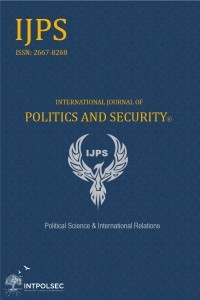Drivers of Political Radicalization and De-radicalization of Terrorism in Northern Nigeria
Terrorism, Radicalization, De-radicalization
___
- References
- Aaron, K. K. (2015). Relative deprivation and insurgency: What lessons from Nigeria’s flawed federalism?. International Area Studies Review, 18(2), 164-181.Adenrele, A. R. (2012). Boko Haram insurgency in Nigeria as a symptom of poverty and political alienation. IOSR Journal of Humanities and Social Science, 3(5), 21-26.Agbiboa, D. (2016). The ongoing campaign of terror in Nigeria: Boko Haram versus the state. Stability: International Journal of Security and Development, 2(3).Agbiboa, D. E. (2013) Why Boko Haram exists: The relative deprivation perspective. African Conflict & Peacebuilding Review, 3(1), 144-157.Aigbokhan, B. E. (2008). Growth, inequality and poverty in Nigeria. Prepared for United Nations Economic Commission for Africa (UNECA). Addis Ababa, Ethiopia.Campbell, J. (2014). Boko Haram: origins, challenges and responses. NOREF Policy Brief.Conteh-Morgan, E. (2004). Collective political violence: an introduction to the theories and cases of violent conflicts. Psychology Press.El-Said, H. (2015). New approaches to countering terrorism: designing and evaluating counter radicalization and de-radicalization programs. Springer.Galtung, J. (1990). Cultural violence. Journal of peace research, 27(3), 291-305Galtung, J. (2004). Violence, war, and their impact: On visible and invisible effects of violence. In Polylog: Forum for Intercultural Philosophy Vol. 5Gent, B. (2017). Contemporary Muslim-Christian encounters: developments, diversity & dialogues.Global Terrorism Index (2016) Measuring and Understanding the Impact of Terrorism, Institute for Economics and Peace. http://economicsandpeace.org/wp-content/uploads/2016/11/Global-Terrorism-Index-2016.2.pdf accessed on 3/9/2017. Global Terrorism Index (2017) Measuring and Understanding the Impact of Terrorism, Institute for Economics and Peace. https://reliefweb.int/sites/reliefweb.int/files/resources/Global%20Terrorism%20Index%202017%20%284%29.pdf accessed on 7/12/2017Gurr, T. R. (1970). Relative deprivation and the impetus to violence. Why Men Rebel, 22-58.Hopkins, T. K., & Wallerstein, I. M. (1982). World-systems analysis: theory and methodology (Vol. 1). Sage Publications, Inc.Hough, P., Malik, S., Moran, A., & Pilbeam, B. (2015). International security studies: theory and practice. Routledge.Husain, T. (2017). Counter Terrorism Approaches: With Reference to Bangladesh. ABC Journal of Advanced Research, 6(1), 9-16.International Center for the Study of Radicalization-ICSR (2019) Countering Violent Extremism and Radicalisation that Lead to Terrorism: Ideas, Recommendations, and Good Practices from the OSCE Region; https://icsr.info/2017/12/07/countering-violent-extremism-radicalisation-lead-terrorism-ideas-recommendations-good-practices-osce-region/ accessed on 13/02/2019. Kaldor, M., & Rangelov, I. (Eds.). (2014). The handbook of global security policy. John Wiley & Sons.Kaldor, M., Martin, M., & Selchow, S. (2007). Human security: a new strategic narrative for Europe. International affairs, 83(2), 273-288.Lewis, J. (2005). Language wars: The role of media and culture in global terror and political violence. Pluto Press.Lin, A. C. (1998). Bridging positivist and interpretivist approaches to qualitative methods. Policy studies journal, 26(1), 162-180.Marsden, S. V. (2017). Introduction. In Reintegrating Extremists (pp. 1-20). Palgrave Macmillan UK.Marsden, S. V. (2017). Introduction. In Reintegrating Extremists (pp. 1-20). Palgrave Macmillan UK.Muller, E. N. (1985). Income inequality, regime repressiveness, and political violence. American sociological review, 47-61.Ogbeide, F. I., Kanwanye, H., & Kadiri, S. (2016). Revisiting the Determinants of Unemployment in Nigeria: Do Resource Dependence and Financial Development Matter?. African Development Review, 28(4), 430-443.Olojo, A. (2013). Nigeria’s troubled North: interrogating the drivers of public support for Boko Haram. Retrieved August, 12, 2014Omotola, J. S. (2008). Combating poverty for sustainable human development in Nigeria: The continuing struggle. Journal of poverty, 12(4), 496-517.Rogers, P. (2012). Nigeria: The generic context of the Boko Haram violence. Monthly Global Security Briefing, 1-5.Stonawski, M., Potančoková, M., Cantele, M., & Skirbekk, V. (2016). The changing religious composition of Nigeria: causes and implications of demographic divergence. The Journal of Modern African Studies, 54(3), 361-387.Walker, I., & Pettigrew, T. F. (1984) Relative deprivation theory: An overview and conceptual critique. British Journal of Social Psychology, 23(4), 301-310.Walsham, G. (1995). Interpretive case studies in research: nature and method. European Journal of information systems, 4(2), 74-81.Weigert, K. M. (2010). Structural violence. Stress of war, conflict and disaster, 126-133.
- ISSN: 2667-8268
- Yayın Aralığı: Yılda 2 Sayı
- Başlangıç: 2019
- Yayıncı: Fikret BİRDİŞLİ
Yumuşak Güç Unsuru Olarak Kamu Diplomasisi
Komünizm Sonrası İslam:Orta Asya'da Din ve Politika (Kitap İncelemesi)
Redouane TOUATI, Halima TOUATI
Drivers of Political Radicalization and De-radicalization of Terrorism in Northern Nigeria
Evaluation of Developments in Afghanistan in the Context of Foreign Policy and Security Issues
Hasan ACAR, Mustafa PEKCANDANOĞLU
President Rodrigo Duterte and the Birth of Radical Democracy in the Philippines
